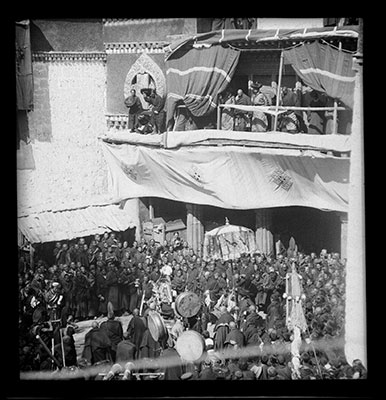
2001.59.1.66.1 (Film negative)


2001.59.1.66.1 (Film negative)

Hugh E. Richardson
Hugh Richardson
April 18th 1939
Lhasa > Jokhang (main entrance from Doring house)
2001.59.1.66.1
58 x 55 mm
Divining , Performing
Negative film nitrate
Donated August 2001
The executors of the estate of Hugh E. Richardson
Hugh E. Richardson
Manual Catalogues - Notes on negative album - '1' 'Chipsha: Dzonggyab [rdzong rgyab]: Torgyap [gtor rgyag] ----- [illegible]' is written in white in Richardson's hand. Notes inside negative album: white label with Richardson's name and address in St. Andrews. [KC 8/7/2006]
Manual Catalogues - Notes on negative index - Folio 66. 'do' [GNAS-CHUNG ORACLE]. [KC 17/7/2006]
Manual Catalogues - Richardson's Hand List: Negative album No.1 no 64. 'The Gnas-chung oracle appears from the Jo-khang where he has a special room. He is in a trance and dances in front of the Jo-khang and the Dalai Lama's room and then rushes after the Gtor-ma. (The Gtor-ma is carried to the outskirts of the city, followd by the troops, a body of monks, and the Gnas chung oracle. It is burnt there, and the troops fire two ancient cannon of Tibetan make, with leather barrels, at a target on a hill on the other side of the river. I have no photographs of that part of the ceremony). [KC 24/7/2006]
Other Information - Background: See Hugh E. Richardson, Ceremonies of the Lhasa Year , 1993, London: Serindia Publications, pp 39-49 for a description of the Monlam Torgya ( mon lam gtor rgyag) ceremony. "The ceremony of Monlam Torgya is the longest and the most spectacular event of the New Year celebrations. It is the high point of the Yaso's tenure of office and the day for which the Tsisher was the preparation. (p. 39) ... A loud burst of oboes and cymbals and some hectic activity at the door of the Jokhang signal the appearance of the Oracle who rushes out in a state of possession grasping his sword and bow. After gyrating round the courtyard, he sets off down the Barkor supported by two stalwart monks, in pursuit of the torma . [KC 24/7/2006]
Other Information - Setting: The figure under the ceremonial parasol ( gdugs zhabs) is the Nechung oracle ( gnas chung sku rtan or gnas chung chos rgyal ). Richardson described the setting of this image in his publication Ceremonies of the Lhasa Year : "A loud burst of oboes and cymbals and some hectic activity at the door of the Jokhang signal the appearance of the Oracle who rushes out in a state of possession grasping his sword and bow. After gyrating round the courtyard, he sets off down Barkhor supported two stalwart monks, in pursuit of the torma" [Serindia Publications, London, 1993, p. 48] [TS 9/9/2005]
Other Information - Dates: Contact prints of the kind that was made of this image which had red development numbers of '6--' seem to have been developed in c.1938. However, Richardson does not seem to have been in Lhasa to witness this ceremony in 1938 and so it seems most likely that the image was taken in 1939 [MS 19/12/2005]
For Citation use:
The Tibet Album.
"Nechung Oracle leaving the Jokhang during Lugong "
05 Dec. 2006. The Pitt Rivers Museum.
<http://tibet.prm.ox.ac.uk/photo_2001.59.1.66.1.html>.
For more information about photographic usage or to order prints, please visit the The Pitt Rivers Museum.
© The Pitt Rivers Museum